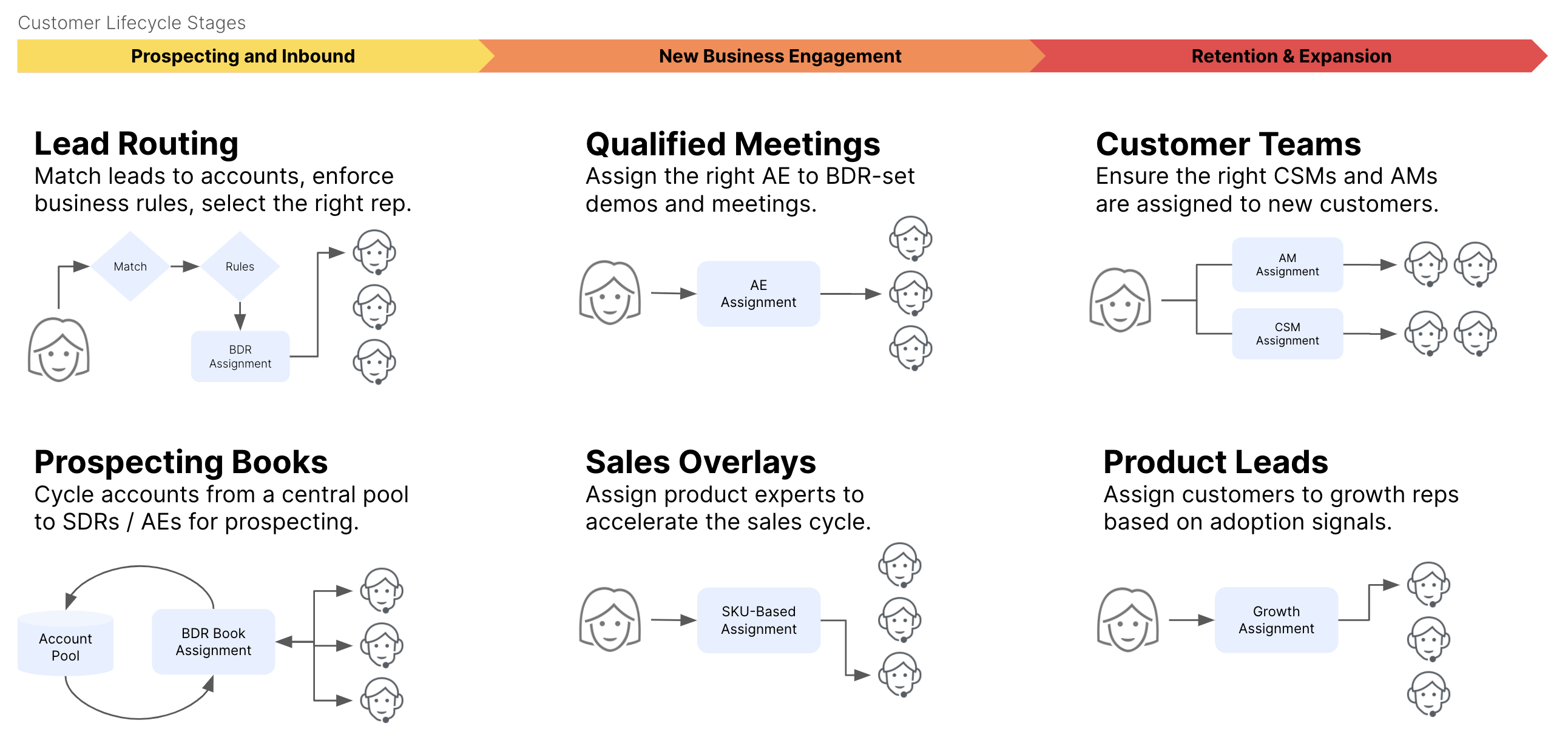As customers progress through your customer lifecycle, they flow through your organization. Those customer flows are the circulatory system of your revenue org - the lifeblood of your company.
You’ve heard us talk about the assignment mullet. We’ve also written about the importance of being intentional with customer handoffs. Today let's discuss all the different kinds of assignment that make up your company's circulatory system, and the ways customers flow through your revenue organization.
Lead Routing
When a new potential prospect shows interest in your product or service, you probably consider them some kind of lead. Someone may sign up for a webinar or other marketing activity, fill out a demo request form on your website, ask for more information from your chatbot, and so on. These inbound leads need to be sent to someone on your sales or business development team.
In some organizations, a new lead may need to be qualified before pursuing it as a serious sales lead. Those leads are typically routed - or assigned - to a business development rep (BDR) for further qualification to decide if this lead is a good fit for a more in-depth new business conversation.
With lead routing, companies are usually concerned with speed. You want to make contact with the interested lead as quickly as possible, because the faster you respond, the more likely that lead is to convert to a full opportunity. In the lead routing stage, sales leaders are typically concerned with things like speed-to-to-lead, SLAs, and response times. Sales leaders also want to be sure a new inbound lead isn’t related to an existing customer or prospect account, so new leads need to be evaluated against existing accounts through a (hopefully automated) lead-to-account matching process.
(Click here to learn more about lead routing with Gradient Works.)
Outbound Prospecting
Prospecting is a lot like the outbound version of inbound lead routing. In this case, someone like a sales development rep (SDR) is tasked with finding and qualifying new potential prospects to engage with. For example, an SDR may own a list of prospects in an ABM campaign, and be responsible for reaching out to those accounts to qualify them for a more in-depth sales conversation.
With outbound prospecting, sales leaders are concerned with managing reps’ books on an ongoing basis. That includes overseeing what companies/prospects are in a rep’s list to reach out to, and who’s responsible for which accounts. Outbound prospects may come from a variety of different sources, so they need to be checked against current accounts and opportunities for possible existing ownership. This typically involves questions about sales territories, rules of engagement (ROE), lead-to-account matching, and the like.
In terms of assignment, outbound prospecting has a lot of similarities to lead routing because it concerns assigning a set of leads to sales reps for outreach.
Account Executive Assignment
Assigning a new prospect account or opportunity to an account executive (AE) involves a lot more than just giving an email address to a sales rep. For example, you may have a sales process where BDRs first go through the qualification process and then hand off qualified leads to Account Executives. But how do you decide which leads to assign to with AEs?
AE assignment is a chance for you to ensure that all your AEs have balanced opportunity relative to their quota capacity, giving them all a fair chance to meet their quota. AEs’ books can easily get out of balance, depending on how you assign new opportunities.
For example, if you have a lot of variation in the length of your sales cycles, some reps may end up holding on to opportunities for a long time and become overwhelmed with new opps while other reps are moving through their opps more quickly. Capacity management is important to balance output across your sales team over time.
In its most basic terms, you might think about AE assignment as pools vs. pods. Some companies have BDR->AE pods that each work a specific territory. One BDR qualifies leads from that territory, and then hands them off to their partner AE.
Generally, our preferred model is a pool of BDRs and a pool of AEs (instead of BDR->AE pods). Pods are less efficient, as we have explained here. But even with a pool of AEs you can assign new opportunities to, you still need to consider how you distribute those opportunities among that pool. We’ve talked a lot more about distribution and assignment in other posts, like this discussion of round robin assignment.
Specialist or Sales Engineer Assignment
In some sales conversations, AEs or AMs may need to bring in a product specialist. That includes sales overlays, sales engineers, and other subject matter experts who can get into the more technical details of certain issues or products. The specialist’s job is to assist with the sale. Typically, companies have fewer specialists than salespeople, so their time needs to be managed carefully.
Specialists should be only assigned to the most optimal deals. They shouldn’t be called into every deal, but instead focused on the biggest deals or deals where they can have the largest impact. Specialist capabilities will need to be matched to each deal, and focused on participating in the highest value opportunities for them.
Customer Success Manager and Account Manager Assignment
Some companies may put the role of Customer Success Manager (CSM) and Account Manager (AM) together, but in other companies, there’s one group responsible for customer success, and another responsible for account management - commercial relationships like renewals and upgrades.
CSMs and AMs tend to be organized around market segment; they're usually assigned to larger customers, or vertical specific accounts. You might have fewer CSMs covering more territories than AEs.
In many cases, CSMs and AMs have a book of accounts that’s allocated (or reallocated) at the beginning of every year. Which means, as new business closes sales leaders have to figure out how to distribute new accounts fairly across teams with existing books. You may end up with a few reallocations a year to rebalance books. Managing customer handoffs here is particularly important, because constantly changing a customer’s main point of contact with your company can be confusing.
If CSMs and AMs have territory-based books, you need figure out how to divvy up those territories. Capacity and load balancing become extremely important in this case. For example, if you have a rep who’s successful at retaining customers, then no one is churning out of their book. So they’ll either be handling more than they have time to manage, and/or they won’t be able to grow their book with new customers. Conversely, you may even be rewarding people who don’t grow their book.
Ultimately, books that get out of balance over the course of the year demand attention, especially if compensation plans are based on quota capacity and balanced books.
Onboarding Assignment
Like some of the other assignments we’ve discussed, onboarding assignments are typically temporary assignments, before a customer account is handed over to a more permanent owner, like a CSM.
Not every customer will go through a manual onboarding process with a specific person or team responsible for helping new customers get started. The customers that do go through an onboarding process may be larger customers or have more complex installs.
One of the most important parts of the onboarding assignment is the handoff itself. An AE needs to communicate clearly with the onboarding team about everything they learned in discovery. They also need to be clear with the new customer about expectations. A bad onboarding handoff starts a customer’s entire paying relationship with a company on the wrong foot.
There’s also potential room for error in the role of the customer’s (future) CSM or AM in onboarding. If this relationship isn’t managed well and clearly with the customer, it can create a bad initial impression. Handoffs are incredibly important throughout the onboarding process.
Product Qualified Lead Assignment
A product qualified lead (PQL) involves identifying specific expansion opportunities based on customer actions in the product. Assigning PQLs is determining if there’s a need to involve someone else beyond the normal CSM/AM relationship to try to win that expansion.
Expansion is the sum of cross-sells and upsells, and your company's exact formula dictates who you involve. Some companies will notify a customer’s AM if they become a PQL. But other companies have a dedicated growth team whose job it is to act on these signals; the growth team receives temporary assignment of a customer during an upsell progress, and then permanent ownership goes back to the CSM. In yet other cases, there may be a new business rep dedicated to that line of business. So depending on the type of organization, a PQL may or may not be an assignment.
As customers flow through your company, they will be assigned to one or more sales or success reps. Those assignments and their associated handoffs and ownership implications are incredibly important to the customer experience. If any one of them isn't working as well as it should, it'll impact everything else in your customer lifecycle.




